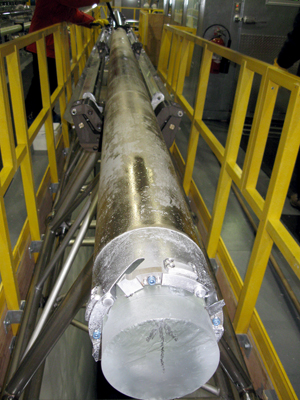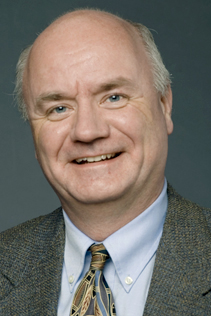News and Notes. . .
Faculty, Staff, and Student News
FACULTY, STAFF, AND STUDENTS from the Ocean Process Analysis Laboratory participated in the 4,000-strong Ocean Sciences Meeting in Portland, Oregon in late February. Assistant professor Linda Kalnejais, research scientist Tim Moore and Ph.D. student Mimi Szeto gave oral presentations. Ph.D. students Deb Goodwin and Amanda Plagge both had poster presentations, and research assistant professor Joe Salisbury co-chaired a poster session.
OPAL’S HUI FENG reports that he was lead author of a paper published in IEEE Geoscience and Remote Sensing Letters entitled “Spline-based nonparametric estimation of the altimeter sea state bias correction.” Doug Vandemark of OPAL is a co-author. Feng notes that the paper comes from a close collaboration with graduate student Shan Yao and associate professor Linyuan Li, both of the UNH College of Engineering and Physical Sciences, and other international collaborators.
THE THIRD DRILLING SEASON of The third drilling season of the West Antarctic Ice Sheet Divide (WAIS Divide) Ice Core Project drew to a close in late January at a depth of 2,561 meters (8,402 feet) about a kilometer (3,280 feet) shy of the project’s final goal. According to Joe Souney of CSRC and operations manager for the WAIS Divide Science Coordination Office (which is operated jointly by UNH and the Desert Research Institute in Nevada), round-the-clock drilling was required to make up for a two-week delay at the beginning of the season due to bad weather. Souney notes that improvements to the state-of-the-art drill made between drilling seasons provided “more ice per run“ and produced “extremely high-quality ice.” When completed next year, the WAIS Divide ice core will provide the most temporally precise record of carbon dioxide for the past ∼100,000 years.
SCOTT OLLINGER of the Complex Systems Research Center co-authored a paper published in Global Change Biology entitled “Albedo estimates for land surface models and support for a new paradigm based on foliage nitrogen concentration.” Dave Hollinger of the U.S. Forest Service in Durham, whom Ollinger notes is a close collaborator on a variety of CSRC research projects, was lead author on the paper. CSRC’s Mary Martin was also a co-author, as was former center faculty member Andrew Richardson. The paper presents a way for the recently discovered relationship between forest albedo and canopy nitrogen to be included in climate models. Ollinger also reports that he gave the lead plenary presentation entitled "NASA Terrestrial Ecosystems Research Synthesis" at NASA's 2010 Terrestrial Ecology meeting March 15th in La Jolla, California.
IN FEBRUARY and early March, CSRC's Erik Hobbie hosted Samson Gumbo of Midlands State University in Zimbabwe as the two discussed a project on rural food security in Zimbabwe with other UNH faculty. The project emphasizes the increased use of local resources (local fruits, climate-appropriate grains), community-focused training, and increasing the relevance of higher education for Zimbabwean rural communities. Hobbie and Gumbo hope the project will also serve as a vehicle for launching a partnership between UNH and Midlands, where Gumbo is a dean of cooperative learning. Hobbie also reports that his paper entitled "Carbon sources for the Paleozoic giant fungus Prototaxites inferred from modern analogues" was published in the Proceedings of the Royal Society B: Biological Sciences in March.
CSRC'S RUTH VARNER, Steve Frolking, Changsheng Li, and Patrick Crill (Stockholm University) were recently awarded a grant from The National Institute for Climatic Change Research (NICCR), a U.S. Department of Energy program in the Office of Biological and Environmental Research. The grant, entitled "Quantifying the importance of episodic release of CH4 in annual wetland methane emissions," will focus on the analysis of automated chamber measurements of CH4 (methane) emissions from Sallie's Fen, a research site in seacoast New Hampshire. The analyses will be incorporated into the Wetland DeNitrification-DeComposition (DNDC) model, a biogeochemical process-based model developed by Li and colleagues, to estimate the annual release of CH4 from these ecosystems. Episodic release of CH4 from wetlands is not well understood and can represent a significant portion of the annual flux of CH4, a radiatively important trace gas.
EBERHARD MÖBIUS reports that former UNH undergraduate student, physics major Morgan O'Neill, received an M.I.T. Presidential Fellowship that provides a full stipend plus tuition for her first year of graduate school. During her four-year tenure at UNH, O’Neill worked on the Interstellar Boundary Explorer (IBEX) mission with Möbius, UNH principal investigator for the mission, and fellow physics major George Clark. The two undergraduates did key work on the satellite’s star sensor, which helps pinpoint the precise direction of the energetic neutral atoms – IBEX’s quarry – that are hurtling straight into our solar system from the far reaches of space. O’Neill is currently a Ph.D. candidate in the Department of Earth, Atmospheres, and Planetary Science at M.I.T. In addition to a full course load she is doing research in atmospheric dynamics with hurricane specialist Kerry Emanuel. As for Clark, he’s carrying on his IBEX work as a Ph.D. student at the Southwest Research Institute in San Antonio, Texas - the lead science institute for the IBEX mission. Clark was awarded a Space Physics Research Fellowship from SwRI, which allows him to pursue his Ph.D. in space physics at the University of Texas at San Antonio while conducting research under lead principal investigator for IBEX Dave McComas.
AMITAVA BHATTACHARJEE, Peter Paul professor of physics, recently received a Fulbright award to spend his sabbatical year (2010-11) at the newly established Laboratoire de Physique des Plasmas (LPP) in Paris. The LPP brings together space and astrophysical plasma physics with fusion – areas of plasma science where international collaboration has been most fruitful, says Bhattacharjee, making the Fulbright award, with expectations that its scholars will be cultural ambassadors, particularly relevant.
CSRC’s GEORGE HURTT was invited to participate in the Department of Energy's Office of Biological and Environmental Research (BER) "Long Term Vision" Workshop held in the Washington, D.C. area in early March. BER has begun a planning process to identify grand-challenge science and to create a long-term vision for the future of biological, climate and environmental research. Hurtt was invited specifically for his expertise in BER-relevant areas of science, the themes for the workshop which were, Climate Change Systems Biology, Information and Synthetic Biology, Systems Integration Framework, and, Research Framework for Energy Sustainability. Hurtt also reports that, in early February, he took part in the National Academy of Science/National Research Council's Committee on the Human Dimensions of Global Change and the Climate Research Committee workshop "Socioeconomic Scenarios for Climate Change Impact and Response Assessments." Among other things, these discussions will inform future scientific work performed as part of the Fifth Assessment by the Intergovernmental Panel on Climate Change.
AND, EOS WELCOMES Karen Burnett-Kurie as the institute’s new Educational Program Coordinator. Karen replaces Clara Kustra, who retired in December after 30 years of service at UNH. Karen is a UNH alumna and has a master’s degree in teaching and extensive and varied experience with managing educational programs through universities and other institutions. She worked at UNH Cooperative Extension with Professor Emeritus Dennis Meadows on projects to educate the public regarding overexploitation of fisheries and other shared resources. She most recently worked at FIRST (For Inspiration and Recognition in Science and Technology) where she organized a far-flung network of participants in that organization's student robotics competitions. Her experience in science and technology education and coordination of large, complex programs will be a great asset as EOS moves forward on its varied educational initiatives. -DS
OPAL’S HUI FENG reports that he was lead author of a paper published in IEEE Geoscience and Remote Sensing Letters entitled “Spline-based nonparametric estimation of the altimeter sea state bias correction.” Doug Vandemark of OPAL is a co-author. Feng notes that the paper comes from a close collaboration with graduate student Shan Yao and associate professor Linyuan Li, both of the UNH College of Engineering and Physical Sciences, and other international collaborators.
 |
| A section of this season's WAIS Divide ice core. The arrow indicates the azimuth of the ice/drill, which rotationally lines the cores up with one another and is important for the scientists who look at the crystals in the cores. Photo by Peter Neff, Univ. of Washington |
SCOTT OLLINGER of the Complex Systems Research Center co-authored a paper published in Global Change Biology entitled “Albedo estimates for land surface models and support for a new paradigm based on foliage nitrogen concentration.” Dave Hollinger of the U.S. Forest Service in Durham, whom Ollinger notes is a close collaborator on a variety of CSRC research projects, was lead author on the paper. CSRC’s Mary Martin was also a co-author, as was former center faculty member Andrew Richardson. The paper presents a way for the recently discovered relationship between forest albedo and canopy nitrogen to be included in climate models. Ollinger also reports that he gave the lead plenary presentation entitled "NASA Terrestrial Ecosystems Research Synthesis" at NASA's 2010 Terrestrial Ecology meeting March 15th in La Jolla, California.
IN FEBRUARY and early March, CSRC's Erik Hobbie hosted Samson Gumbo of Midlands State University in Zimbabwe as the two discussed a project on rural food security in Zimbabwe with other UNH faculty. The project emphasizes the increased use of local resources (local fruits, climate-appropriate grains), community-focused training, and increasing the relevance of higher education for Zimbabwean rural communities. Hobbie and Gumbo hope the project will also serve as a vehicle for launching a partnership between UNH and Midlands, where Gumbo is a dean of cooperative learning. Hobbie also reports that his paper entitled "Carbon sources for the Paleozoic giant fungus Prototaxites inferred from modern analogues" was published in the Proceedings of the Royal Society B: Biological Sciences in March.
CSRC'S RUTH VARNER, Steve Frolking, Changsheng Li, and Patrick Crill (Stockholm University) were recently awarded a grant from The National Institute for Climatic Change Research (NICCR), a U.S. Department of Energy program in the Office of Biological and Environmental Research. The grant, entitled "Quantifying the importance of episodic release of CH4 in annual wetland methane emissions," will focus on the analysis of automated chamber measurements of CH4 (methane) emissions from Sallie's Fen, a research site in seacoast New Hampshire. The analyses will be incorporated into the Wetland DeNitrification-DeComposition (DNDC) model, a biogeochemical process-based model developed by Li and colleagues, to estimate the annual release of CH4 from these ecosystems. Episodic release of CH4 from wetlands is not well understood and can represent a significant portion of the annual flux of CH4, a radiatively important trace gas.
EBERHARD MÖBIUS reports that former UNH undergraduate student, physics major Morgan O'Neill, received an M.I.T. Presidential Fellowship that provides a full stipend plus tuition for her first year of graduate school. During her four-year tenure at UNH, O’Neill worked on the Interstellar Boundary Explorer (IBEX) mission with Möbius, UNH principal investigator for the mission, and fellow physics major George Clark. The two undergraduates did key work on the satellite’s star sensor, which helps pinpoint the precise direction of the energetic neutral atoms – IBEX’s quarry – that are hurtling straight into our solar system from the far reaches of space. O’Neill is currently a Ph.D. candidate in the Department of Earth, Atmospheres, and Planetary Science at M.I.T. In addition to a full course load she is doing research in atmospheric dynamics with hurricane specialist Kerry Emanuel. As for Clark, he’s carrying on his IBEX work as a Ph.D. student at the Southwest Research Institute in San Antonio, Texas - the lead science institute for the IBEX mission. Clark was awarded a Space Physics Research Fellowship from SwRI, which allows him to pursue his Ph.D. in space physics at the University of Texas at San Antonio while conducting research under lead principal investigator for IBEX Dave McComas.
AMITAVA BHATTACHARJEE, Peter Paul professor of physics, recently received a Fulbright award to spend his sabbatical year (2010-11) at the newly established Laboratoire de Physique des Plasmas (LPP) in Paris. The LPP brings together space and astrophysical plasma physics with fusion – areas of plasma science where international collaboration has been most fruitful, says Bhattacharjee, making the Fulbright award, with expectations that its scholars will be cultural ambassadors, particularly relevant.
CSRC’s GEORGE HURTT was invited to participate in the Department of Energy's Office of Biological and Environmental Research (BER) "Long Term Vision" Workshop held in the Washington, D.C. area in early March. BER has begun a planning process to identify grand-challenge science and to create a long-term vision for the future of biological, climate and environmental research. Hurtt was invited specifically for his expertise in BER-relevant areas of science, the themes for the workshop which were, Climate Change Systems Biology, Information and Synthetic Biology, Systems Integration Framework, and, Research Framework for Energy Sustainability. Hurtt also reports that, in early February, he took part in the National Academy of Science/National Research Council's Committee on the Human Dimensions of Global Change and the Climate Research Committee workshop "Socioeconomic Scenarios for Climate Change Impact and Response Assessments." Among other things, these discussions will inform future scientific work performed as part of the Fifth Assessment by the Intergovernmental Panel on Climate Change.
AND, EOS WELCOMES Karen Burnett-Kurie as the institute’s new Educational Program Coordinator. Karen replaces Clara Kustra, who retired in December after 30 years of service at UNH. Karen is a UNH alumna and has a master’s degree in teaching and extensive and varied experience with managing educational programs through universities and other institutions. She worked at UNH Cooperative Extension with Professor Emeritus Dennis Meadows on projects to educate the public regarding overexploitation of fisheries and other shared resources. She most recently worked at FIRST (For Inspiration and Recognition in Science and Technology) where she organized a far-flung network of participants in that organization's student robotics competitions. Her experience in science and technology education and coordination of large, complex programs will be a great asset as EOS moves forward on its varied educational initiatives. -DS
by David Sims, Science Writer, Institute for the Study of Earth, Oceans, and Space. Published in Winter 2010 issue of EOS .

